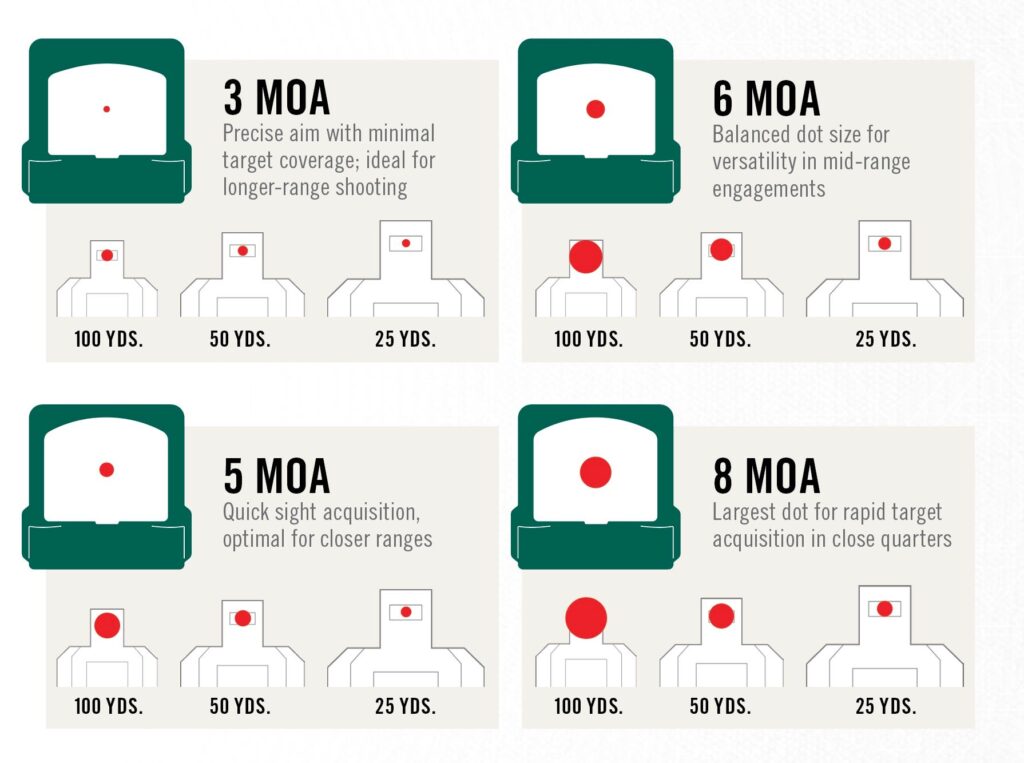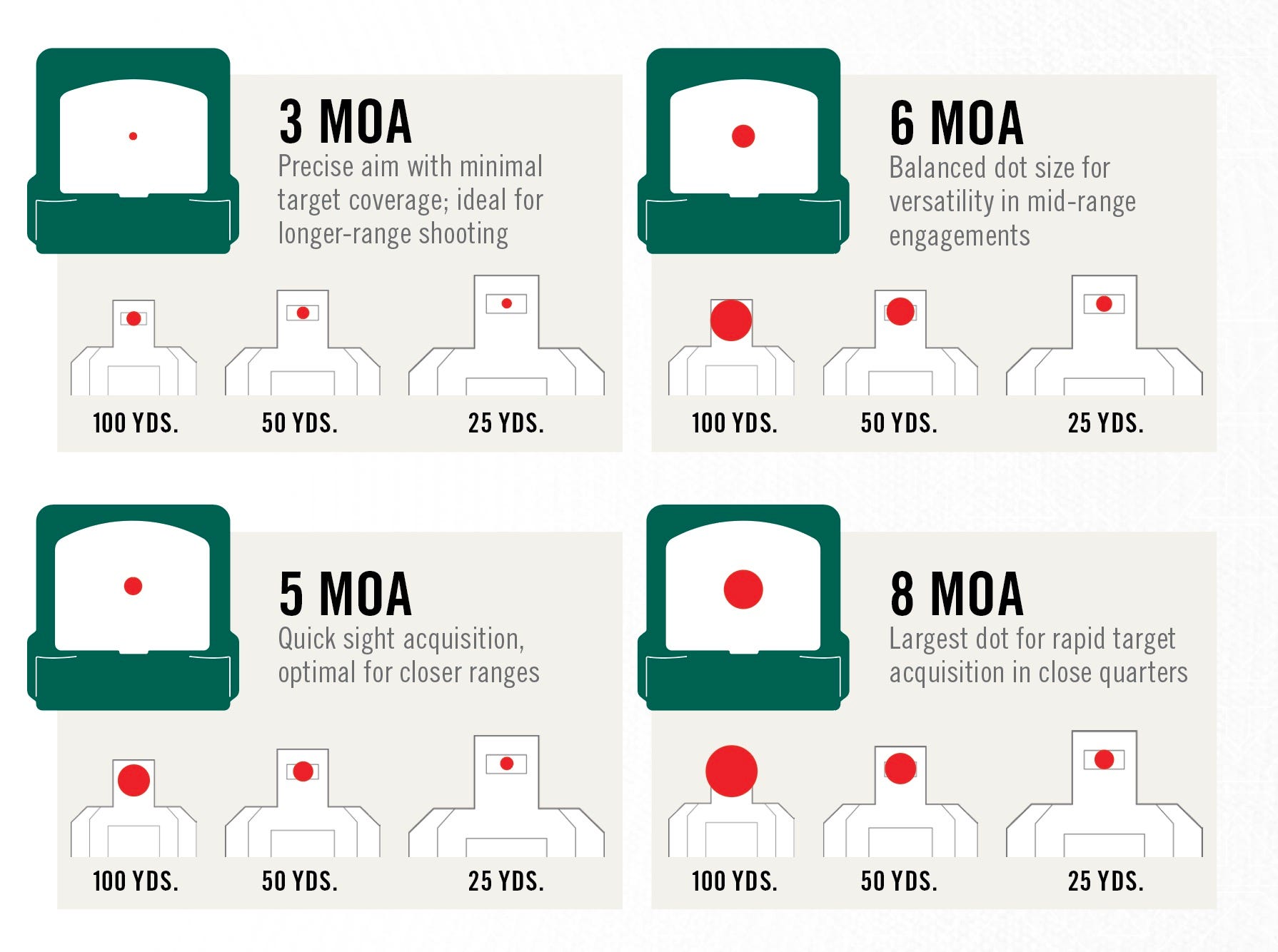
2.5 MOA vs 6 MOA Red Dot Sights: Which is Right for You?
Choosing the right red dot sight can dramatically improve your shooting accuracy and speed. Among the key considerations is the size of the red dot itself, typically measured in Minutes of Angle (MOA). Two common sizes are 2.5 MOA and 6 MOA. This article will delve into the differences between a 2.5 MOA red dot and a 6 MOA red dot, exploring their respective strengths, weaknesses, and ideal use cases. Understanding these nuances will help you select the optic that best suits your needs, whether you’re a competitive shooter, a hunter, or someone looking for a reliable home defense solution.
Understanding MOA
Before diving into the specifics, let’s clarify what MOA means. One MOA corresponds to approximately 1 inch at 100 yards. Therefore, a 6 MOA red dot covers about 6 inches at 100 yards, while a 2.5 MOA red dot covers only 2.5 inches at the same distance. This difference in size significantly impacts target acquisition and precision.
2.5 MOA Red Dot: Precision and Long-Range Accuracy
Advantages of a 2.5 MOA Red Dot
- Enhanced Precision: The smaller dot size allows for more precise aiming, particularly at longer distances. This is because the smaller dot obscures less of the target, enabling a clearer view and finer adjustments.
- Ideal for Long-Range Shooting: For scenarios where accuracy is paramount, such as precision shooting or hunting, a 2.5 MOA red dot is often preferred. The reduced dot size minimizes the potential for covering the target, leading to more accurate shots.
- Reduced Target Obscuration: Especially at longer distances, a smaller dot ensures that less of the target is covered, allowing for a clearer view and better shot placement.
Disadvantages of a 2.5 MOA Red Dot
- Slower Target Acquisition: The smaller dot can be more challenging to acquire quickly, especially in dynamic shooting situations or under stress. This is because the eye needs to work harder to locate and focus on the smaller dot.
- Less Forgiving at Close Range: While precise, the smaller dot may require more focused concentration at close ranges, potentially slowing down your reaction time in close-quarters combat (CQB) scenarios.
- Dimmer Appearance: Some users may find a 2.5 MOA red dot to appear dimmer than a larger dot, particularly in bright sunlight. This can make it more difficult to see and acquire the dot quickly.
6 MOA Red Dot: Speed and Close-Range Dominance
Advantages of a 6 MOA Red Dot
- Faster Target Acquisition: The larger dot is much easier to see and acquire quickly, making it ideal for fast-paced shooting scenarios, such as competitive shooting or self-defense situations.
- Ideal for Close-Range Shooting: In CQB environments, the larger dot allows for rapid target engagement and quick follow-up shots. The increased visibility of the dot is especially beneficial when speed is critical.
- More Visible in Bright Light: The larger dot tends to be more visible in bright sunlight, making it easier to use in various lighting conditions.
Disadvantages of a 6 MOA Red Dot
- Reduced Precision: The larger dot covers more of the target, making it more difficult to achieve precise shots, especially at longer distances. This can lead to decreased accuracy and wider shot groups.
- Not Ideal for Long-Range Shooting: The larger dot obscures too much of the target at longer distances, making it challenging to aim accurately. It’s generally not recommended for precision shooting or hunting applications.
- Potential for Target Obscuration: At longer ranges, the larger dot can completely cover smaller targets, making it impossible to see the point of impact.
Choosing the Right MOA: Key Considerations
Selecting between a 2.5 MOA red dot and a 6 MOA red dot depends heavily on your intended use and shooting style. Consider the following factors:
Intended Use
- Home Defense: For home defense, where engagements are typically at close range, a 6 MOA red dot is often preferred for its faster target acquisition.
- Competitive Shooting: Competitive shooters often use 6 MOA red dots for pistol competitions that emphasize speed and close-range accuracy. For rifle competitions with longer distances, a 2.5 MOA red dot might be more suitable.
- Hunting: Hunters often opt for a 2.5 MOA red dot for its precision and ability to make accurate shots at longer distances.
- General Purpose: For general-purpose use, consider your typical shooting distances and prioritize either speed or precision accordingly.
Shooting Style
- Aggressive Shooters: If you prioritize speed and quick target acquisition, a 6 MOA red dot is likely a better choice.
- Precision Shooters: If you value accuracy and are willing to sacrifice some speed, a 2.5 MOA red dot is more suitable.
Vision
- Astigmatism: Individuals with astigmatism may experience a distorted or starburst effect with red dots. In such cases, a smaller 2.5 MOA red dot might appear less distorted than a larger 6 MOA red dot. However, this can vary greatly from person to person.
- Eye Fatigue: Some users find that a larger dot is easier on the eyes, especially during extended shooting sessions.
Testing and Experimentation
The best way to determine which MOA size is right for you is to test both a 2.5 MOA red dot and a 6 MOA red dot on your firearm. Visit a local shooting range and try them out under various conditions. Pay attention to how quickly you can acquire targets, how accurately you can shoot at different distances, and how the dot appears to your eye.
Other Considerations
Besides the MOA size, consider other factors when choosing a red dot sight:
- Brightness Settings: Ensure the sight has adjustable brightness settings to accommodate different lighting conditions.
- Battery Life: Look for a sight with long battery life to minimize the need for frequent battery changes.
- Durability: Choose a sight that is durable and can withstand the rigors of regular use.
- Mounting Options: Ensure the sight is compatible with your firearm and has appropriate mounting options.
Conclusion
The choice between a 2.5 MOA red dot and a 6 MOA red dot ultimately depends on your individual needs and preferences. A 2.5 MOA red dot offers enhanced precision and is ideal for longer-range shooting, while a 6 MOA red dot provides faster target acquisition and is better suited for close-range engagements. By carefully considering your intended use, shooting style, and vision, you can select the red dot sight that will best enhance your shooting performance. Experimentation and testing are key to finding the perfect fit.
Ultimately, both the 2.5 MOA red dot and the 6 MOA red dot are valuable tools. Consider your typical shooting distances, the types of targets you engage, and your personal comfort level when making your decision. A well-chosen red dot sight can significantly improve your accuracy and speed, making you a more effective shooter. [See also: Red Dot Sight Maintenance Tips] and [See also: Choosing the Right Optic for Your AR-15]

